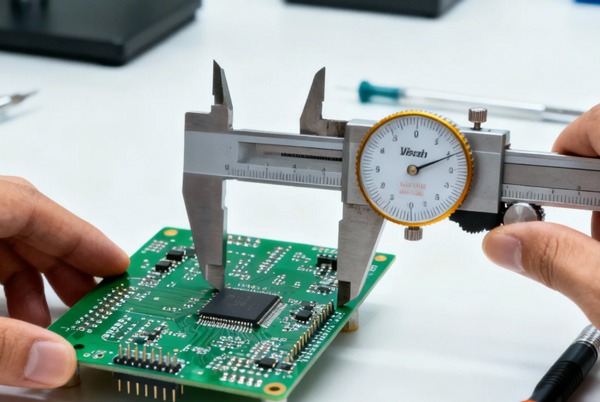Inhaltsübersicht
Lösungen zur Prüfung elektrischer Eigenschaften
(1) Wurde der Einfluss von Leiterwiderstand, Induktivität und Kapazität analysiert?
Lösung: Verwenden Sie eine kombinierte Methode aus Simulationsanalyse und tatsächlichen Tests. Verwenden Sie SI/PI-Simulationstools (z. B. HyperLynx, ADS), um vor dem Layout parasitäre Parameter zu extrahieren und die Signalintegrität bei hohen Frequenzen sowie die Impedanz des Stromversorgungsnetzwerks zu analysieren. Implementieren Sie für Hochgeschwindigkeitsschaltungen ein Impedanzanpassungsdesign und eine Topologieoptimierung, die durch Zeitbereichsreflektometrie-Messungen verifiziert werden. Legen Sie PCB-Designregeln fest und setzen Sie strenge Anforderungen an die Länge und Breite kritischer Signalleitungen (z. B. Takte, Differentialpaare). Verwenden Sie die Vier-Leiter-Methode zur Messung des Leiterwiderstands im Milliohm-Bereich, einen Netzwerkanalysator für Induktivitätsparameter und ein LCR-Messgerät für die verteilte Kapazität. Vergleichen Sie die Ergebnisse mit den Designspezifikationen, um sicherzustellen, dass die parasitären Parameter innerhalb der zulässigen Grenzen liegen, und verhindern Sie so Signalverzerrungen, Timing-Probleme und elektromagnetische Störungen.
(2) Entsprechen der Abstand und die Form der Leiterbefestigungen den Isolationsanforderungen?
Lösung: Führen Sie eine doppelte Überprüfung von DFM (Design for Manufacturability) und DFA (Design for Reliability) durch. Bestimmen Sie den Mindestabstand entsprechend der Spannungsebene auf der Grundlage der IPC-2221-Normen (z. B. 0,1 mm Abstand für 100 V Gleichstrom). Verwenden Sie CAM-Software für automatische Abstandskontrollen und implementieren Sie ein verstärktes Isolationsdesign für Hochspannungsbereiche (z. B. Leistungsmodule).Optimieren Sie die Leiterecken mit 45-Grad-Winkeln oder Bögen, um eine Konzentration des elektrischen Feldes durch scharfe Winkel zu vermeiden. Führen Sie Spannungsfestigkeitsprüfungen durch, indem Sie 1 Minute lang das 2- bis 3-fache der Betriebsspannung anlegen, um sicherzustellen, dass kein Durchschlag auftritt. Führen Sie eine elektromagnetische Feldsimulation für Hochfrequenzschaltungen durch und analysieren Sie Randfeldeffekte, um sicherzustellen, dass die Isolationsanforderungen unter tatsächlichen Betriebsbedingungen erfüllt werden.
(3) Werden die Isolationswiderstandswerte an kritischen Stellen kontrolliert und festgelegt?
Lösung: Establish a critical point insulation resistance control system. Identify key areas such as high-voltage zones, high-frequency circuits, and high-impedance applications, marking insulation resistance test points in the design. Select appropriate insulating materials (e.g., FR-4, polyimide) according to IEC-60112 standards, with surface treatment using solder mask. Use an insulation resistance tester (e.g., megohmmeter) to measure at 500V DC, ensuring insulation resistance ≥100MΩ at key locations (≥10MΩ under high temperature/humidity). Implement accelerated life testing, monitoring insulation resistance decay over 500 hours at 85°C/85% RH, ensuring the product meets safety standards throughout its lifecycle.
(4) Ist die Polarität vollständig identifiziert?
Lösung: Build a multiple-polarity identification and error-proofing system. During PCB layout, use standardized packages for polar components (e.g., electrolytic capacitors, diodes, connectors), clearly marking polarity symbols (+, – △) on the silkscreen layer. Establish a DFA checklist requiring polarity mark size ≥1.5mm, positioned ≤0.5mm from the component body. Use asymmetric package designs to prevent 180-degree misinsertion. In the assembly process, set up AOI (Automated Optical Inspection) polarity check stations, using color recognition technology to distinguish polarity direction. Create first-article samples before mass production, verified by 3 independent personnel 3 times, ensuring the polarity identification system is reliable and effective.
(5) Wurde der Einfluss des Leiterabstands auf den Kriechstromwiderstand und die Spannung aus geometrischer Sicht bewertet?
Lösung: Implementieren Sie ein kollaboratives Design der elektrischen Leistung auf der Grundlage geometrischer Parameter. Verwenden Sie eine Software zur Simulation elektromagnetischer Felder (z. B. ANSYS HFSS), um geometrische PCB-Modelle zu erstellen und die Verteilung des elektrischen Feldes sowie den Leckstrom bei verschiedenen Abständen zu analysieren. Erstellen Sie eine Referenztabelle für Abstände und Spannungen gemäß den IPC-2221A-Standards (z. B. 0,1 mm für 50 V, 0,2 mm für 100 V).Verwenden Sie Schlitzdesigns für Hochspannungsanwendungen, um den Kriechweg zu vergrößern, und implementieren Sie geerdete koplanare Wellenleiterstrukturen für Hochfrequenzsignale. Überprüfen Sie die Impedanzkontinuität durch TDR-Messungen und verwenden Sie einen Oberflächenwiderstandsmesser, um den Leckwiderstand zu messen. Erstellen Sie eine Designregelbibliothek, die geometrische Parameter mit der elektrischen Leistung verknüpft und eine automatisierte Überprüfung und Optimierung ermöglicht.
(6) Sind die Medien mit veränderten Oberflächenbeschichtungen zertifiziert?
Lösung: Establish a surface coating change certification process. Any coating change must pass complete qualification testing, including adhesion test (cross-cut ≥4B), chemical resistance test (resisting flux, cleaners), and dielectric constant measurement (1kHz-1GHz band). Perform damp heat cycling tests (-40°C to +85°C, 1000 cycles) to evaluate insulation resistance stability. Use SEM to analyze coating thickness uniformity (target 15-30μm). For high-frequency circuits, measure the coating’s impact on signal loss (≤0.02dB/inch). Establish a qualified supplier list, requiring material certificates and RoHS compliance certificates for each batch, ensuring consistent and reliable coating performance.

Lösungen zur Prüfung physikalischer Eigenschaften
(1) Sind alle Polster und ihre Positionen für die Endmontage geeignet?
Lösung: Implement DFA-based pad optimization design. Use 3D modeling software (e.g., SolidWorks PCB) for virtual assembly, verifying component pad-to-housing clearance (≥0.5mm). Optimize pad dimensions according to IPC-7351 standards, establishing a component library update mechanism. Implement a pad steal design for BGA devices to prevent solder bridging. Use stepped pad designs to address height restrictions. Create assembly verification fixtures for actual insertion testing. Establish pad design specifications, clearly defining solder mask dam size (≥0.1mm), pad-to-trace transition ratios, ensuring solder yield ≥99.5%.
(2) Erfüllt die montierte Leiterplatte die Anforderungen hinsichtlich Stoß- und Vibrationsfestigkeit?
Lösung: Build a mechanical reliability verification system. Select appropriate test standards (e.g., JESD22-B104) based on the product application environment (e.g., automotive, industrial). Perform modal analysis during the design phase to avoid coincident natural frequencies with operating frequencies (safety factor ≥1.35). Add mechanical fixation (e.g., screws, adhesive) for components weighing ≥15g. Conduct vibration tests (5-500Hz, 1 hour per axis) and shock tests (half-sine wave, 50G, 6ms). Use high-speed cameras to analyze board assembly dynamic response, and strain gauges to measure stress at key points. Optimize PCB support point layout, ensuring no component detachment, solder joint cracks, or other failures after reliability testing.
(3) Wie groß ist der Abstand der angegebenen Standardkomponenten?
Lösung: Establish component spacing standards based on process capability. Develop tiered spacing specifications according to IPC-7351 and actual factory process levels: chip components ≥0.3mm, SOIC devices ≥0.6mm, QFP devices ≥0.8mm, BGA devices ≥0.5mm. Add an additional 0.5mm clearance for components beneath heat sinks. Automatically validate spacing compliance using DFM inspection software. Implement a local spacing exemption process for high-density designs, subject to process validation. Establish a component database containing 3D models and recommended spacing. New components must undergo spacing compatibility review before being added to the database to ensure manufacturability.
(4) Sind lose montierte Komponenten oder schwerere Teile sicher befestigt?
Lösung: Implement specialized fixation solutions for heavy components. Create a list of components weighing ≥5g or size ≥15mm, mandating mechanical fixation. Use screws + washers for transformers and large electrolytic capacitors, specifying screw torque (e.g., 0.6N·m ±10%). Use high-temperature adhesive for medium-sized components, verifying bond strength after 24 hours at 85°C. Reserve space for fixation structures around heavy components during design. Specify fixation operation procedures in process documents, setting dedicated inspection points for fixation stations. After mechanical shock testing, use X-ray to inspect the solder joint and the fixation structure integrity, ensuring secure fixation.
(5) Ist die Wärmeableitung für Heizelemente korrekt? Sind sie von der Leiterplatte und anderen wärmeempfindlichen Komponenten isoliert?
Lösung: Build a thermal design and management verification system. Use thermal simulation software (e.g., FloTHERM) to identify heat sources and thermally sensitive components, optimizing layout spacing (≥5mm between heat sources and thermally sensitive components). Use thermal vias (0.3mm diameter, 1mm pitch) for power devices, connected to internal ground planes for heat dissipation. Ensure thermal grease thickness is 0.1-0.15mm at the interface when adding heat sinks. Perform infrared thermal imaging tests, verifying actual temperatures do not exceed 85% of rated values. Implement thermal isolation measures for high-temperature areas: adding heat shields, using high-temperature solder, and setting up heat dissipation channels. Establish temperature rise test standards, ensuring maximum PCB surface temperature difference ≤25°C.
(6) Sind Spannungsteiler und andere mehrpolige Bauteile korrekt positioniert?
Lösung: Implement precise positioning control for multi-lead components. Use an optical positioning system (e.g., Fiducial Mark), placing ≥2 fiducials around each multi-lead component, 0.5-1mm from pads. For high-precision components like voltage dividers, maintain symmetry and equal-length routing during layout to minimize temperature gradient effects. Use package designs with pad center-to-center accuracy of ±0.05mm. Set component image recognition parameters in the placement program, with rotation tolerance ≤1°. Verify positioning accuracy on the first article using a 3D measuring instrument, sampling every 2 hours during mass production. Establish a multi-lead component database containing recommended layouts and inspection requirements, ensuring positioning consistency.
(7) Ist die Anordnung und Ausrichtung der Komponenten für die Inspektion geeignet?
Lösung: Optimize component layout for visual inspection. Develop component orientation standards: unify direction for the same type of component (e.g., all chip pin 1s facing left), polarity marks facing the same direction. Ensure component spacing allows AOI camera viewing angle ≥45°, and 100% probe accessibility. Reserve inspection windows adjacent to bottom-termination components (e.g., QFN). Implement a layered inspection strategy for high-density areas: inspect large components first, then use microscopes for fine-pitch components. Establish a DFA checklist containing 25 visibility criteria. Create inspection fixtures, verifying 100% inspection coverage and ≤0.1% false call rate.

(8) Wurden alle potenziellen Interferenzen zwischen der Leiterplatte und der gesamten Platinenbaugruppe beseitigt?
Lösung: Implement system-level interference analysis and elimination strategies. Use 3D modeling for mechanical interference checking, ensuring clearance to housing and connectors ≥0.3mm. Set keep-out zones around tall components, with ≥2mm spacing from adjacent boards. Match coefficients of thermal expansion to avoid structural interference from temperature cycling. Optimize assembly sequence, installing short/small components before tall/large ones. Create rapid prototypes for assembly verification, using feeler gauges to measure critical clearances. Establish an interference check matrix covering all possible combination states, ensuring no risk of physical interference.
(9) Sind die Abmessungen der Positionierungslöcher korrekt?
Lösung: Establish a positioning hole accuracy control system. According to IPC-2221 standards, the positioning hole diameter should be 0.1-0.3mm larger than the fixing pin (for board edge holes) or 0.05-0.1mm larger (for internal holes). For 4-layer boards, set a keep-out zone (≥1.5 times hole diameter) around positioning holes. For plated positioning holes, ensure the inner wall copper thickness ≥25μm for mechanical strength. Check the first article of each PCB batch using pin gauges for hole diameter (tolerance ±0.05mm), and a CMM for hole position accuracy (±0.1mm). Install positioning detection sensors in assembly fixtures, with automatic alarms for anomalies, ensuring 100% positioning reliability.
(10) Sind die Toleranzen vollständig und angemessen?
Lösung: Implement process capability-based tolerance design. Analyze process capability indices (Cp≥1.33, Cpk≥1.0) for each PCB manufacturing and assembly step, setting reasonable tolerances: line width tolerance ±10%, hole position tolerance ±0.05mm, board warpage ≤0.75%. Use statistical tolerance analysis to avoid tolerance stack-up exceeding limits. Implement tightened tolerance control for critical dimensions, e.g., BGA pad diameter tolerance ±0.02mm. Establish a tolerance allocation table, clearly defining responsibilities for design, manufacturing, and assembly. Use GD&T standards on drawings, regularly review tolerance applicability, and continuously optimize based on actual yield data.
(11) Wurden die physikalischen Eigenschaften aller Beschichtungen geprüft und qualifiziert?
Lösung: Establish a full lifecycle quality management system for coatings. Set physical property standards for solder mask, silkscreen, and surface finishes (e.g., ENIG, OSP): solder mask thickness 15-25μm, adhesion ≥4B, hardness ≥6H. Perform sampling inspection for each incoming batch: use thickness gauges for uniformity, cross-cut test for adhesion, wear resistance tester for hardness. Conduct accelerated aging tests (1000 hours at 85°C/85% RH) to verify physical property stability. Establish a material traceability system, strictly control storage conditions (temperature 15-30°C, humidity <60%), clearly mark expiration dates, and ensure consistent and reliable coating performance.
(12) Liegt das Verhältnis zwischen Loch- und Leitungsdurchmesser innerhalb eines akzeptablen Bereichs?
Lösung: Implement aperture and lead matching design controls. According to IPC-2221 standards, set appropriate aspect ratios for different component types: Through-hole components require apertures 0.2-0.4mm larger than lead diameter, with a 0.1-0.3mm solder pad; press-fit components require apertures 0.05-0.1mm larger than lead diameter. Employ DFM analysis software to automatically verify aperture ratio compliance. Implement microvia design for high-density boards while ensuring the aperture ratio does not exceed 10:1 (board thickness: aperture diameter). Fabricate aperture ratio verification prototypes and conduct through-hole solder fill rate testing, requiring a fill rate ≥75%. Establish aperture ratio design specifications; new components must pass aperture ratio compatibility review before inventory acceptance to ensure reliable solderability.
(13) Erfüllt die Leiterplatte die Anforderungen an die elektromagnetische Verträglichkeit (EMV)?
Lösung: Erstellen Sie ein komplettes EMV-Kontrollsystem vom Entwurf bis zum Test. Implementieren Sie während des Entwurfs eine SI/PI/EMV-Co-Simulation, um potenzielle Störquellen und empfindliche Schaltungen zu identifizieren. Verwenden Sie eine mehrschichtige Erdungsstrategie, um digitale, analoge und Stromversorgungsbereiche voneinander zu isolieren. Stellen Sie vollständige Referenzflächen für Hochgeschwindigkeitssignale bereit und vermeiden Sie Kreuzspaltungen. Platzieren Sie Erdungs-Vias zur Abschirmung um Taktschaltungen herum und verwenden Sie Streifenleitungsstrukturen für kritische Signale.Fügen Sie die erforderlichen Filterschaltungen hinzu (z. B. Ferritperlen, TVS-Dioden). Verwenden Sie EMV-Prüfgeräte (Spektrumanalysator, EMI-Empfänger) für Vorab-Konformitätsprüfungen und zur Diagnose von Problemen mit abgestrahlten und leitungsgebundenen Emissionen. Stellen Sie durch Layout-/Routing-Optimierung, Hinzufügen von Abschirmungen usw. die Konformität mit FCC-, CE- und anderen EMV-Normen sicher, damit die Zertifizierungsprüfungen beim ersten Versuch bestanden werden.
